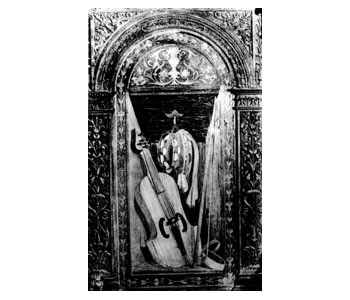 By Robert Jesselson
By Robert Jesselson
(originally published in Strings Magazine, February 1991 issue)
As string players and teachers using the words “violin,” “fiddle,” and “cello” with great frequency, how often do we stop to consider the origin of these words? It is perhaps intriguing to uncover the relationship between the term “violin” and the Roman goddess of exaltation or victory, but it is probably even more surprising to discover that there is an etymological relationship between our stringed instruments and the device used to torture slaves! Research into the early names of the instruments, however, is not idle intellectual curiosity. Rather, the implications are profound with respect to the early literature for the cello.
The word “violin” originates from the Latin “vitula.” The word “vitulare” meant “to sing or rejoice.” “Vitula” also referred to a fiddle, as well as a calf or heifer. (Were these words related by the fact that the heifer was used for making the gut strings of the fiddle?) The word “vitula” became “fides” (meaning string or lute) and evolved into “fidula” and “fithela” (Old English), finally becoming the modern English “fiddle.” The Latin word “fidicula” referred to a small lute or a mechanism to bind slaves in order to torture them.
The word “vitula” evolved separately into the Old French word “vielle,” which became the Medieval word “vyell.” Much of the confusion in terminology between the violin and viol families stems from this source-word. Instead of developing two separate names for the two very different families, both groups of instruments derive their names from the same word. “Vyell” became “viol” and ultimately “violone” as the generic term for the viol family. “Vyell” also served as the source for the Old Provencal term “viola,” which was the prime term for the violin family (“viola da braccio”). The diminutive instrument became the “violino,” while the larger instrument took the augmentative form “violone” (large viola). Since both families of instruments employed the ambiguous word “violone,” the potential for confusion is enormous.
Part of the importance in determining the correct interpretation of the word “violone” is in being able to ascertain when music began to be written specifically for the cello. Much early music specifies performance on a “violone.” If it can be established that “violone” referred to the violoncello as early as the 16th century, then it can be appreciated that some literature which was thought to have been written for the viol family may in fact have been intended for the cello.
Although it is known that the cello existed as early as 1535 (in a fresco painted by Gaudenzio Ferrari showing an angel playing the cello), current scholarship says that the cello did not emerge as a solo instrument until more than 150 years later. Numerous different names were used for the instrument and it is often unclear whether a “violone” or a “bassus” referred to the cello or some other instrument. At various times the violoncello has been called a variety of names, indicated below with the source and dates of usage: Bas de violon (Jambe de Fer, 1556); basso di viola da braccio (Zacconi, 1592); basso da brazzo (Monteverdi, 1607); bass vio de braccio (Praetorius, 1619); Gross Quint-Bass (Praetorius, 1619); Basse de violon (Mersenne, 1637); violoncino (Fontana, 1641); violoncello (Arresti, 1665); violone da Brazzo (Vitali, 1666).
Other terms known to have referred to the modern violincello include violone, bassus, französische bass, bas-geig, bass violin, Bass Geige, bassel, Bassetl, bassetto, Bassetschen, viola de basso, viulunzeel, violoncello da chiesa (larger size), violoncello da camera (smaller size, or modern cello size), violonzino, violonzelo, violoncelo, and cello (used as early as 1765 by C.P.E. Bach).
Other cello-like variants have included violin cello piccolo (called for in Bach cantatas and Boccherini quintets), violoncello alto, violincello d’amore (a small cello with sympathetic strings), violincello da spalla (a cello held by a strap, referred to by Jambe de Fer in 1556, arpeggione (also called guitare d’amore, guitar violincello and bowed guitar), gardon (a Transylvanian folk instrument with three or four strings used as a rhythm instrument), and baryton (a South German instrument with six bowed strings and 20 sympathetic strings).
The first unequivocal reference to the violincello was in Jambe de Fer’s Epitome Musical in 1556, where he indicated that the Italians call the family “violin da braccia ou violine” and referred to the cello as “le bas” or “le bas de violin.” Monteverdi calls for cellos in the score to Orfeo (1607) under the name “basso de viola da braccio” or “basso da brazzo.” The most confusing term is the above-mentioned “violone.” In Volume II of his Syntagma Musicum (1619), Praetorius states that the violine refers to the contrabass (double bass) viola da gamba. Although this may have been true for Germany, it does not appear to have been true for Italy, where violone seems to have referred specifically to the cello. Giovanni Battista Vitali, a recognised cellist, signs himself in his Op. 1 and Op. 5 as “Musico de Violone da Brazzo,” thus equating the violone with the cello.
The first appearance of the term ‘violoncino’ came in 1641 in the title page of a score by G.B. Fontana. The suffixes “-ino,” “-elo” and “-ello” simply diminutives in different Italian dialects. Hence the term “violincino” is a cognate for “violincello” and translates as “little large viola” (“viol-“ refers to the violin family, “-on” means “large” and “cello” means “little”).
The term “violincello” first appeared in the Sonatas by Arresti in 1665. By the 1680s, the name was increasingly accepted in Italy, although the term “violone” was still used. There are even examples where the term “violoncello” is on the title page “violone” appears on the parts.
The question of nomenclature and terminology is confused still further by the fact that there was little standardization with the instrument itself. It was made in several sizes, with either four, five, or six strings and with a variety of tunings. In his Syntagma Musicum, Praetorius referred to a five-string cello which he called the “bass viol da braccio.” The tuning also varied, since he wrote, “Take heed, now, it is of no great import how this all that person tunes his violin all viola if only he can perform on it accurately, clearly, and in tune.”

